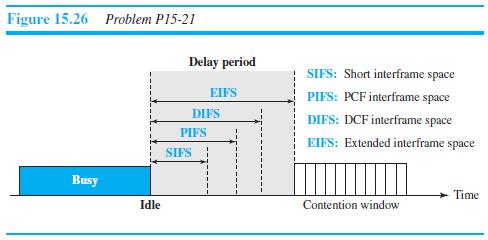Question: An 802.11 network may use four different interframe spaces (IFSs) to delay the transmission of a frame in different situations. This allows low-priority traffic to
An 802.11 network may use four different interframe spaces (IFSs) to delay the transmission of a frame in different situations. This allows low-priority traffic to wait for high-priority traffic when the channel becomes idle. Normally, four different IFSs are used in different implementations, as shown in Figure 15.26. Explain the purpose of these IFSs (you may need to do some research using the Internet).
Figure 15.26

Figure 15.26 Problem P15-21 Delay period SIFS: Short interframe space EIFS PIFS: PCF interframe space DIFS DIFS: DCF interframe space PIFS EIFS: Extended interframe space SIFS Busy Time Idle Contention window
Step by Step Solution
3.47 Rating (157 Votes )
There are 3 Steps involved in it
We describe each IFS below a The short interframe space SIFS is used to allow the two parties in a s... View full answer

Get step-by-step solutions from verified subject matter experts


